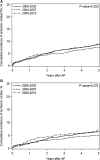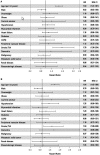No Decline in the Risk of Stroke Following Incident Atrial Fibrillation Since 2000 in the Community: A Concerning Trend
- PMID: 27412902
- PMCID: PMC4937280
- DOI: 10.1161/JAHA.116.003408
No Decline in the Risk of Stroke Following Incident Atrial Fibrillation Since 2000 in the Community: A Concerning Trend
Abstract
Background: While atrial fibrillation is a recognized risk factor for stroke, contemporary data on trends in stroke incidence after the diagnosis of atrial fibrillation are scarce.
Methods and results: Olmsted County, MN residents with incident atrial fibrillation or atrial flutter (collectively referred to as AF) from 2000 to 2010 were identified. Cox regression determined associations of year of AF diagnosis with ischemic stroke and transient ischemic attack (TIA) occurring through 2013. Among 3247 AF patients, 321 (10%) had an ischemic stroke/TIA over a mean of 4.6 years (incidence rate [95% CI] per 100 person-years: 2.14 [1.91-2.38]). Two hundred thirty-nine (7%) of 3265 AF patients experienced an ischemic stroke (incidence rate: 1.54 [1.35-1.75]). The risk of both outcomes remained unchanged over time after adjusting for demographics and comorbidities (hazard ratio [95% CI] per year of AF diagnosis: 1.00 [0.96-1.04] for ischemic stroke/TIA; 1.01 [0.96-1.06] for ischemic stroke only). In analyses restricted to patients with prescription information, the rates of anticoagulation use did not change over time, reaching 50.8% at 1 year after AF diagnosis. Further adjustment for anticoagulation use did not alter the temporal trends in stroke incidence (hazard ratio [95% CI] per year of AF diagnosis: 1.06 [0.97-1.15] for ischemic stroke/TIA; 1.08 [0.98-1.20] for ischemic stroke only).
Conclusions: Strokes/TIAs are frequent after AF, occurring in 10% of patients after 5 years of follow-up. The occurrence of stroke/TIA did not decline over the last decade, which may be influenced by a leveling off of anticoagulation use. This concerning trend has major public health implications.
Keywords: atrial fibrillation; ischemic stroke; temporal trends; transient ischemic attack.
© 2016 The Authors and Mayo Foundation for Medical Education and Research. Published on behalf of the American Heart Association, Inc., by Wiley Blackwell.
Figures





References
-
- Go AS, Hylek EM, Phillips KA, Chang Y, Henault LE, Selby JV, Singer DE. Prevalence of diagnosed atrial fibrillation in adults: national implications for rhythm management and stroke prevention: the anticoagulation and risk factors in atrial fibrillation (ATRIA) study. JAMA. 2001;285:2370–2375. - PubMed
-
- Miyasaka Y, Barnes ME, Gersh BJ, Cha SS, Bailey KR, Abhayaratna WP, Seward JB, Tsang TSM. Secular trends in incidence of atrial fibrillation in Olmsted County, Minnesota, 1980 to 2000, and implications on the projections for future prevalence. Circulation. 2006;114:119–125. - PubMed
-
- Colilla S, Crow A, Petkun W, Singer DE, Simon T, Liu X. Estimates of current and future incidence and prevalence of atrial fibrillation in the U.S. adult population. Am J Cardiol. 2013;112:1142–1147. - PubMed
-
- Coyne KS, Paramore C, Grandy S, Mercader M, Reynolds M, Zimetbaum P. Assessing the direct costs of treating nonvalvular atrial fibrillation in the United States. Value Health. 2006;9:348–356. - PubMed
-
- Kim MH, Johnston SS, Chu B‐C, Dalal MR, Schulman KL. Estimation of total incremental health care costs in patients with atrial fibrillation in the United States. Circ Cardiovasc Qual Outcomes. 2011;4:313–320. - PubMed
Publication types
MeSH terms
Grants and funding
LinkOut - more resources
Full Text Sources
Other Literature Sources
Medical

